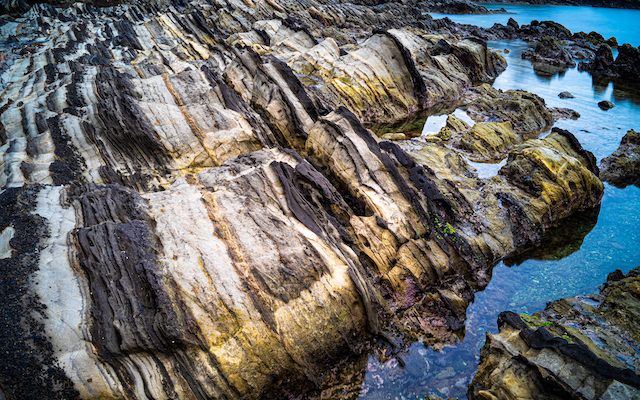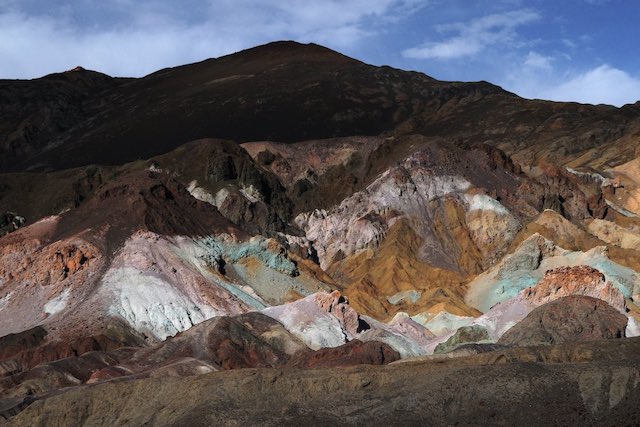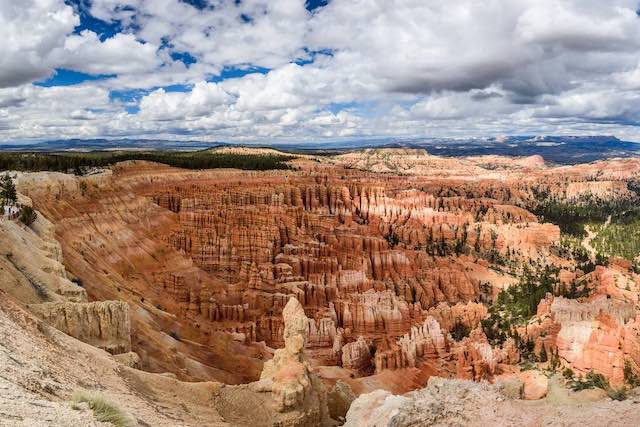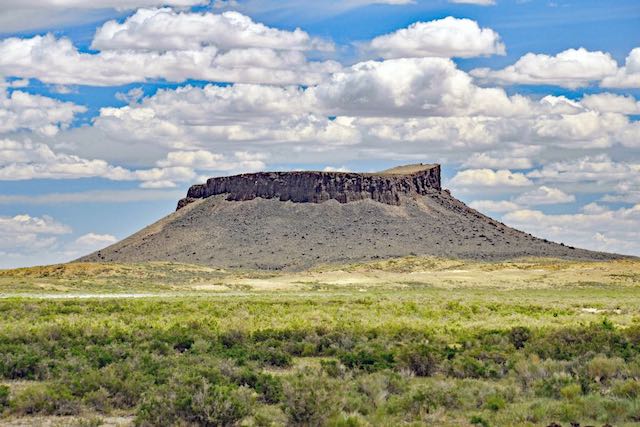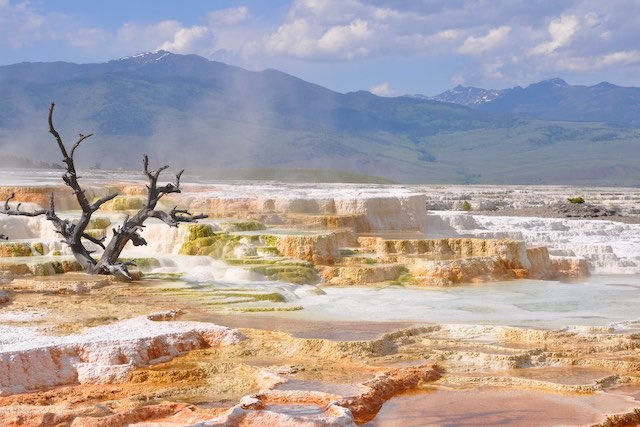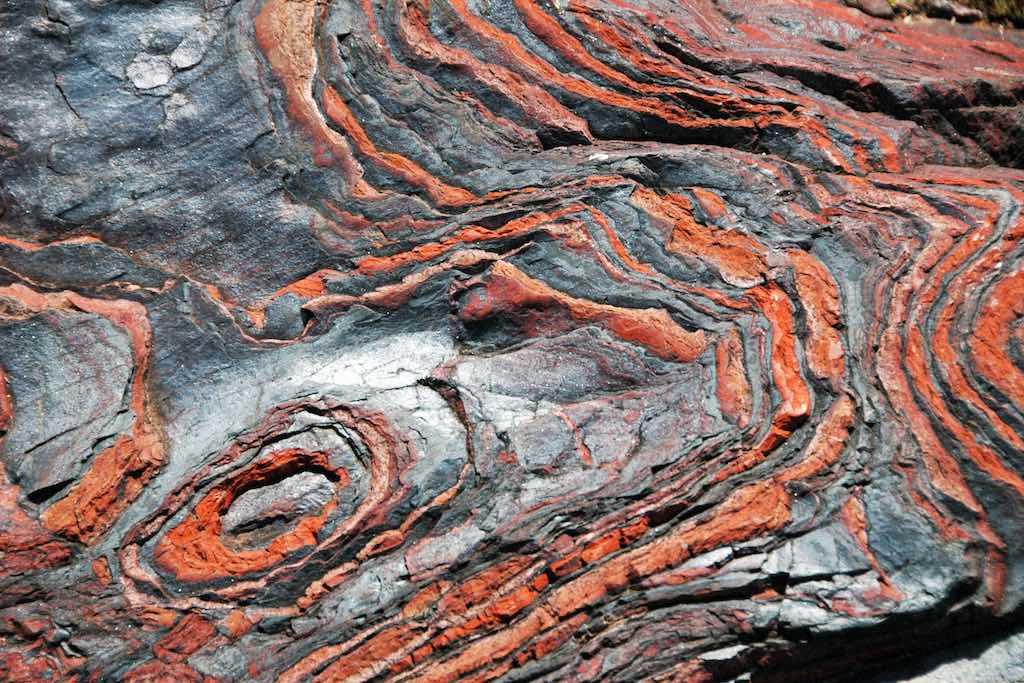
Stripes made of iron and jasper
This rock, with its beautiful stripes of alternating bright red and dull shiny silver, is about 2.1 billion years old and is called a banded iron formation (BIF). It is exposed on the southern side of Lake Superior, one of the Great Lakes, in the suburbs of Ishpeming, Michigan, USA.
Banded iron formation is a general term for rocks in which iron-based minerals and silicon dioxide-based minerals overlap each other to form a striped pattern about 0.5 to 3 centimeters thick, and many have been found in old strata around the world. The strata are squishy and deformed due to crustal movement, and because they are rich in iron, they are much heavier (denser) than ordinary rocks.
And there are many variations of banded iron formations, some of which are given special rock names. The rock name of the banded iron formation in the photo is jasperite. As you can see from the name, it is a rock that contains jasper, a type of gemstone.
The composition of jasper is basically the same as that of quartz, which is mainly composed of silicon dioxide. Impurities such as oxidized iron (rusty iron) are mixed in with the silicon dioxide, resulting in the bright red color. In other words, the red part in the stripe pattern is jasper.
On the other hand, the blackish-silver part is iron ore, made of magnetite and hematite, which are iron oxide minerals.
2,000 kilometers of huge iron mines
The banded iron formation on the outskirts of Ishpeming forms a small hill called Jasper Knob. This photo shows the scene.
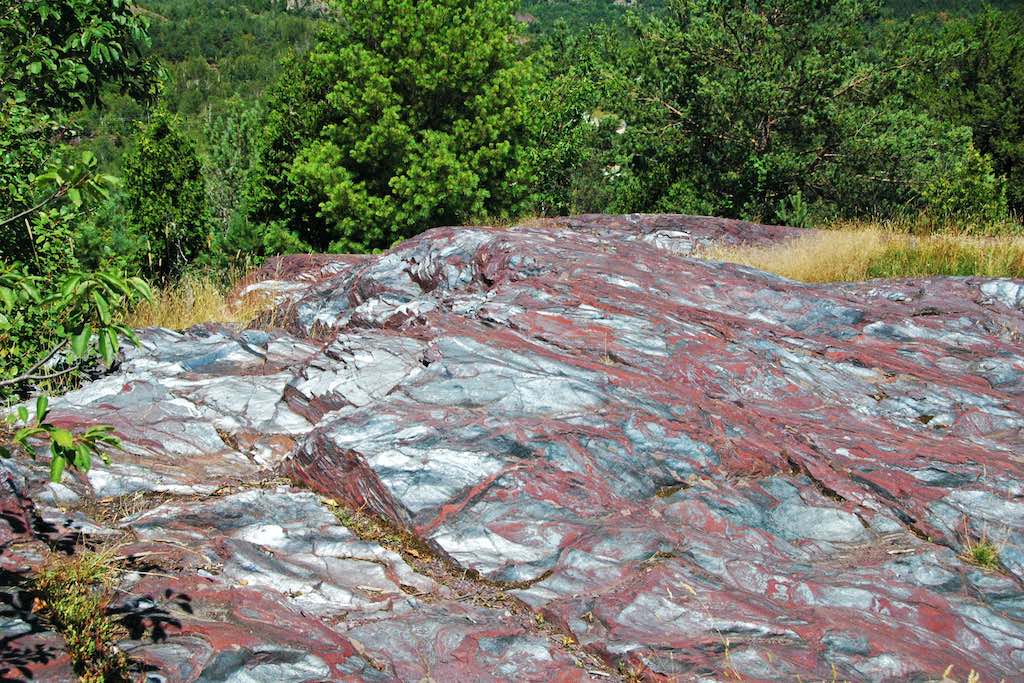
However, this is only a small part of the total distribution. The banded iron formation in this area stretches for more than 2,000 kilometers from eastern Canada to the Lake Superior area. This is the most famous and vast distribution area of banded iron formations in the world.
I would like to take a look at the banded iron formation from the perspective of resources. Banded iron formations, which are distributed all over the world including the North American continent, are the most important iron ore on earth, not only because of their large scale but also because most of them are of a quality that can be used as a resource.
Iron is a metal that has supported human civilization since ancient times, and is still used in large quantities today. However, while there are concerns about the depletion of various metals, there are no concerns about the depletion of iron for some reason. This is despite the fact that we use so much of it.
The reason for this is that huge iron mines called banded iron formations are spread all over the world, and their reserves are far greater than the amount of iron used by humans. It’s a very gratifying story.
Formation of banded iron ores ended 1.8 billion years ago
However, we cannot rest easy when we consider the distant future. The banded iron formation was formed more than 1.8 billion years ago (Jasper Knob from about 2.1 billion to 1.9 billion years ago) and has not formed at all since then, with the exception of a period about 700 million years ago. It is an “extinct” species of rock, so to speak, and no new banded iron formation will ever form, either on Earth today or in the future. It is the “end of the line” when it is gone, even though it is in the distant future.
The reason why the banded iron formation will not form on the present Earth is that its formation process is deeply related to the increase of oxygen, a major event that has occurred only once in the 4.6 billion years of the Earth’s history.
Before the appearance of photosynthetic microorganisms (called cyanobacteria) on the earth, the earth’s atmosphere was composed of carbon dioxide and nitrogen, with little oxygen. The first photosynthetic organisms appeared about 3.2 billion years ago, and fossil evidence indicates that photosynthesis by large numbers of cyanobacteria began at least about 2.7 billion years ago.
Now, there was already a certain amount of oxygen at the time the banded iron formation was formed, but if this oxygen did not combine with iron, the iron oxide minerals (magnetite and hematite) that make up the banded iron formation would not have been produced. Where did the iron come from?
In fact, it is believed that rocks on land were scoured by erosion and transported to the oceans, and iron was dissolved into seawater from such sediments. However, although the ocean is an ocean, it is not a shallow sea but a deep sea floor.
I wrote that oxygen was available to some extent due to the activities of photosynthetic organisms long before the formation of the banded iron ore beds, but that was in the shallow ocean and atmosphere, and it is thought that oxygen did not reach the deep sea. Since iron is stably soluble in seawater under anoxic conditions, iron-rich seawater would have formed at the bottom of the deep sea. Another theory is that iron was supplied directly from beneath the seafloor by hydrothermal eruptions associated with volcanic activity on the seafloor.
In any case, iron-rich seawater was formed at the bottom of the deep sea, and this seawater moved with the deep sea current and eventually rose to the ocean surface. Then, when it reaches the shallow ocean (like a continental shelf) where oxygen is released by photosynthetic organisms, the iron in the seawater reacts with oxygen to form the iron oxide of the banded iron ore beds.
The formation of the banded iron formation ended about 1.8 billion years ago, when all the iron dissolved in seawater under oxygen-free conditions was oxidized. Since then, a large amount of iron dissolved in seawater has never been reproduced, and probably never will be, so the banded iron formation has become an “extinct” species of rock.
Despite years of research, the formation process of the banded iron formation is still shrouded in mystery, and the reasons for the stripes and the band-like extension of the distribution area are still largely unknown.
References
Katsuaki Watanabe (2020) Utsukushisugiru chigaku Jiten (Handbook of the Most Beautiful Geological Wonders), Tokyo: Shuwa System [published in Japanese].

